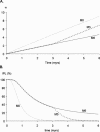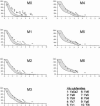Modeling the amplification dynamics of human Alu retrotransposons
- PMID: 16201008
- PMCID: PMC1239904
- DOI: 10.1371/journal.pcbi.0010044
Modeling the amplification dynamics of human Alu retrotransposons
Abstract
Retrotransposons have had a considerable impact on the overall architecture of the human genome. Currently, there are three lineages of retrotransposons (Alu, L1, and SVA) that are believed to be actively replicating in humans. While estimates of their copy number, sequence diversity, and levels of insertion polymorphism can readily be obtained from existing genomic sequence data and population sampling, a detailed understanding of the temporal pattern of retrotransposon amplification remains elusive. Here we pose the question of whether, using genomic sequence and population frequency data from extant taxa, one can adequately reconstruct historical amplification patterns. To this end, we developed a computer simulation that incorporates several known aspects of primate Alu retrotransposon biology and accommodates sampling effects resulting from the methods by which mobile elements are typically discovered and characterized. By modeling a number of amplification scenarios and comparing simulation-generated expectations to empirical data gathered from existing Alu subfamilies, we were able to statistically reject a number of amplification scenarios for individual subfamilies, including that of a rapid expansion or explosion of Alu amplification at the time of human-chimpanzee divergence.
Conflict of interest statement
Figures




Similar articles
-
Alu repeats and human genomic diversity.Nat Rev Genet. 2002 May;3(5):370-9. doi: 10.1038/nrg798. Nat Rev Genet. 2002. PMID: 11988762 Review.
-
Recently integrated Alu retrotransposons are essentially neutral residents of the human genome.Gene. 2006 May 24;373:138-44. doi: 10.1016/j.gene.2006.01.020. Epub 2006 Mar 9. Gene. 2006. PMID: 16527433
-
Lineage specific evolution of the VNTR composite retrotransposon central domain and its role in retrotransposition of gibbon LAVA elements.BMC Genomics. 2015 May 16;16(1):389. doi: 10.1186/s12864-015-1543-z. BMC Genomics. 2015. PMID: 25981446 Free PMC article.
-
Retrotransposition of Alu elements: how many sources?Trends Genet. 2004 Oct;20(10):464-7. doi: 10.1016/j.tig.2004.07.012. Trends Genet. 2004. PMID: 15363897
-
The L1-dependant and Pol III transcribed Alu retrotransposon, from its discovery to innate immunity.Mol Biol Rep. 2021 Mar;48(3):2775-2789. doi: 10.1007/s11033-021-06258-4. Epub 2021 Mar 16. Mol Biol Rep. 2021. PMID: 33725281 Free PMC article. Review.
Cited by
-
Alu insertion polymorphisms shared by Papio baboons and Theropithecus gelada reveal an intertwined common ancestry.Mob DNA. 2019 Nov 26;10:46. doi: 10.1186/s13100-019-0187-y. eCollection 2019. Mob DNA. 2019. PMID: 31788036 Free PMC article.
-
Analysis of the features and source gene composition of the AluYg6 subfamily of human retrotransposons.BMC Evol Biol. 2007 Jul 1;7:102. doi: 10.1186/1471-2148-7-102. BMC Evol Biol. 2007. PMID: 17603915 Free PMC article.
-
Different evolutionary fates of recently integrated human and chimpanzee LINE-1 retrotransposons.Gene. 2007 Apr 1;390(1-2):18-27. doi: 10.1016/j.gene.2006.08.029. Epub 2006 Sep 16. Gene. 2007. PMID: 17055192 Free PMC article.
-
Estimating the age of retrotransposon subfamilies using maximum likelihood.Genomics. 2009 Jul;94(1):78-82. doi: 10.1016/j.ygeno.2009.04.002. Epub 2009 Apr 18. Genomics. 2009. PMID: 19379804 Free PMC article.
-
Source gene composition and gene conversion of the AluYh and AluYi lineages of retrotransposons.BMC Evol Biol. 2009 May 14;9:102. doi: 10.1186/1471-2148-9-102. BMC Evol Biol. 2009. PMID: 19442302 Free PMC article.
References
-
- Lander ES, Linton LM, Birren B, Nusbaum C, Zody MC, et al. Initial sequencing and analysis of the human genome. Nature. 2001;409:860–921. - PubMed
-
- Ostertag EM, Kazazian HH., Jr Biology of mammalian L1 retrotransposons. Annu Rev Genet. 2001;35:501–538. - PubMed
-
- Batzer MA, Deininger PL. Alu repeats and human genomic diversity. Nat Rev Genet. 2002;3:370–379. - PubMed
-
- Smit AF. Interspersed repeats and other mementos of transposable elements in mammalian genomes. Curr Opin Genet Dev. 1999;9:657–663. - PubMed
-
- Jurka J. Evolutionary impact of human Alu repetitive elements. Curr Opin Genet Dev. 2004;14:603–608. - PubMed
Publication types
MeSH terms
Substances
Grants and funding
LinkOut - more resources
Full Text Sources

